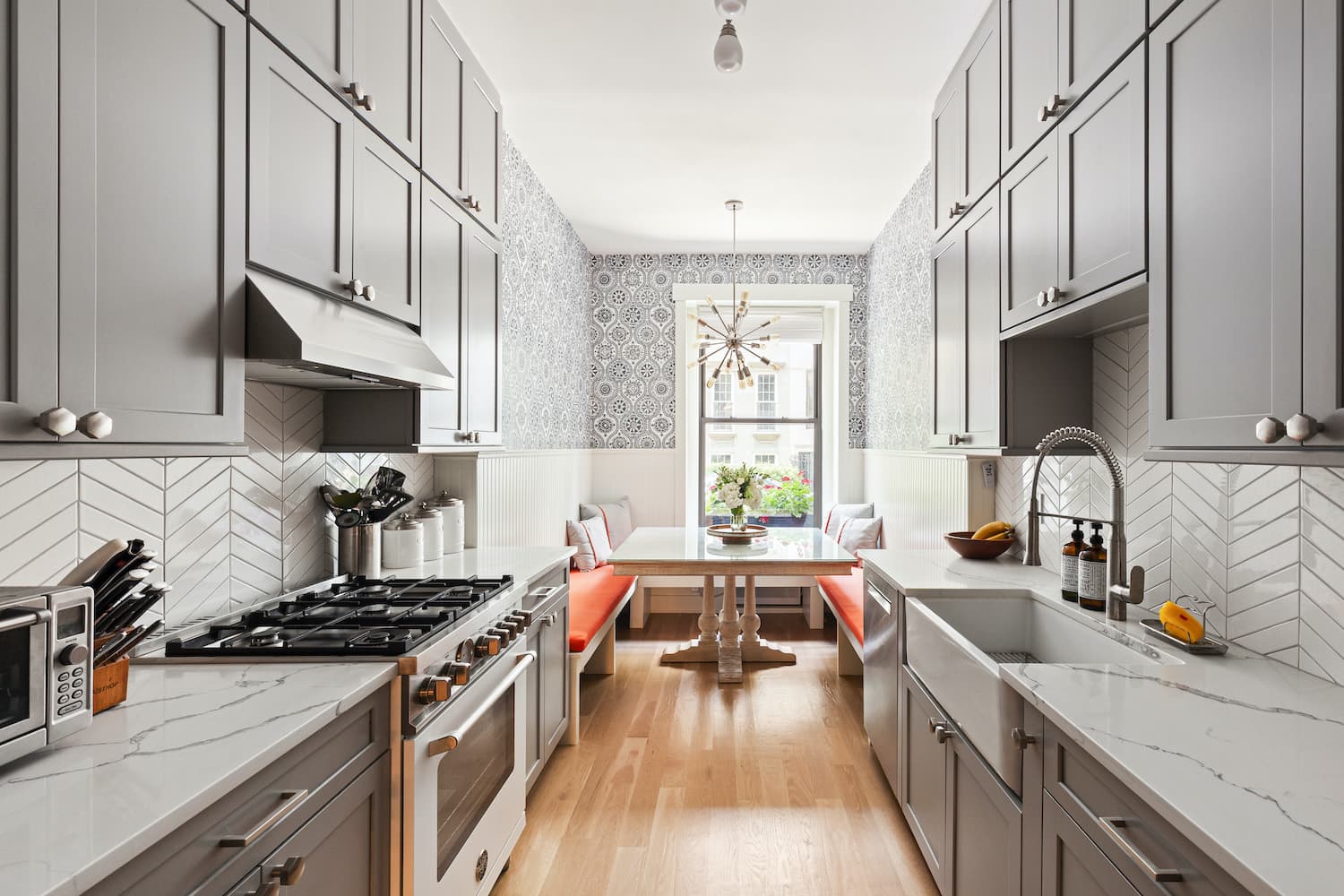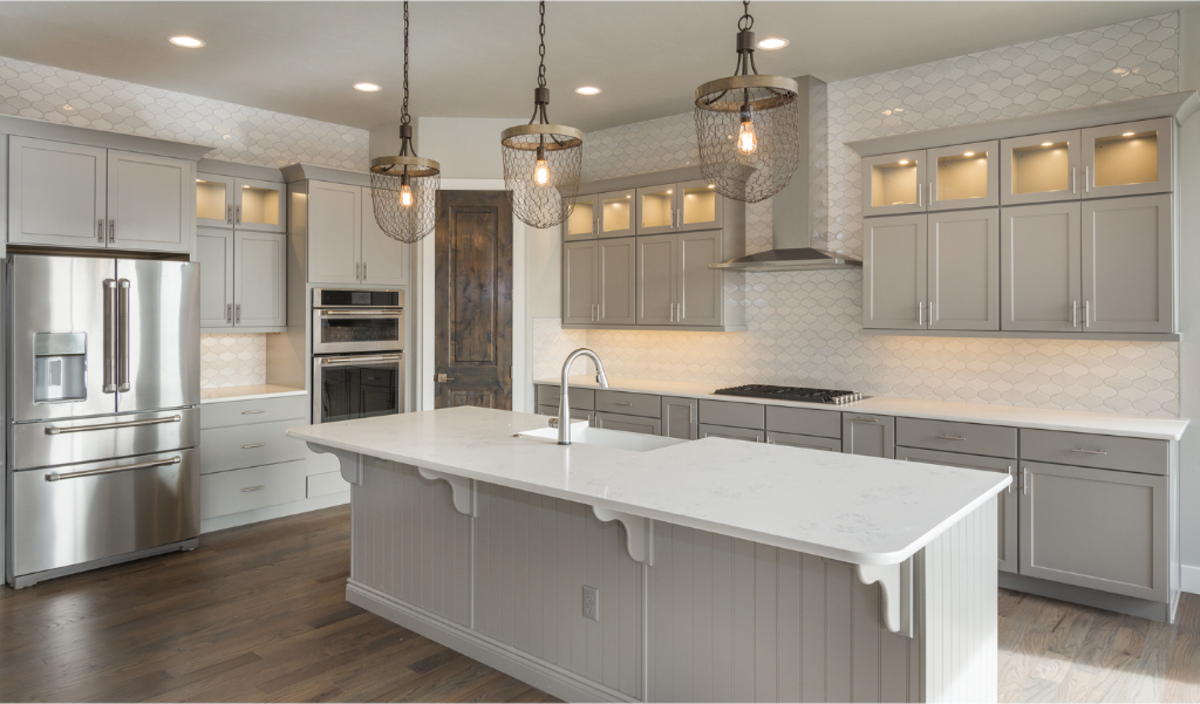Home>diy>Home Improvement>How To Pay For A Kitchen Renovation


Home Improvement
How To Pay For A Kitchen Renovation
Modified: January 9, 2024
Need a kitchen renovation? Discover smart ways to pay for your project with home improvement financing options. Get started today!
(Many of the links in this article redirect to a specific reviewed product. Your purchase of these products through affiliate links helps to generate commission for Storables.com, at no extra cost. Learn more)
Introduction
Renovating your kitchen can significantly enhance the functionality, aesthetic appeal, and value of your home. However, one of the most common challenges homeowners face when planning a kitchen renovation is figuring out how to pay for it. The cost of a kitchen renovation can vary greatly depending on factors such as the size of your kitchen, the scope of the project, the quality of materials used, and whether you plan to hire a professional contractor or undertake the project yourself.
In this article, we will explore different financing options to help you pay for your kitchen renovation. Whether you’re considering a minor upgrade or a complete overhaul, finding the right financial solution can ensure a smooth and stress-free renovation experience.
Key Takeaways:
- When planning a kitchen renovation, assess your needs, set a realistic budget, and explore financing options such as personal savings, home equity loans, and government assistance programs to ensure a successful and affordable transformation.
- To save money on your kitchen renovation, consider DIY tasks, shop for discounts, reuse existing items, and focus on essential upgrades. Careful planning and smart choices can help you achieve a stunning kitchen within your budget.
Read more: How To Pay For A Renovation
Assessing Your Kitchen Renovation Needs
Before jumping into the financial aspect of your kitchen renovation, it’s important to assess your needs and determine what changes you want to make in your kitchen. Take a close look at your current kitchen and identify areas that require improvement. Are you looking to update the cabinets and countertops, replace the appliances, or create more storage space? Understanding your renovation goals will help you plan your budget more effectively.
Consider the layout and flow of your kitchen. Are you satisfied with the existing layout, or do you need to make structural changes? Think about whether you want to expand the kitchen, remove walls, or add an island. These decisions will impact the overall cost of your renovation.
Another factor to consider is the style and design of your kitchen. Are you looking for a modern, sleek look or a more traditional and cozy ambiance? Think about the materials, finishes, and color schemes that align with your vision. Take some time to research different kitchen styles to gather inspiration and ideas for your renovation project.
Furthermore, assess the condition of your kitchen’s plumbing, electrical systems, and ventilation. If these systems require updates or repairs, it’s essential to factor in those costs into your renovation budget.
By thoroughly assessing your kitchen renovation needs, you can better determine the scope of the project and set realistic goals. This will ultimately help you find the most suitable financing options for your kitchen renovation.
Setting a Budget for Your Kitchen Renovation
Setting a budget for your kitchen renovation is a crucial step in the planning process. It allows you to have a clear understanding of how much you can afford to spend and helps you avoid overspending or going over your financial limits. Here are some steps to help you set a realistic budget for your kitchen renovation:
1. Evaluate your finances: Begin by assessing your current financial situation. Take a close look at your income, savings, and existing debts. Determine how much you can comfortably allocate to your kitchen renovation without putting too much strain on your finances.
2. Research average costs: Take some time to research and gather information about the average costs associated with a kitchen renovation. This includes materials, labor, appliances, and any additional expenses such as permits or professional fees. Having a general idea of the costs will provide a starting point for your budget.
3. Identify your priorities: Decide which aspects of the renovation are most important to you. If you have a limited budget, you may need to make some compromises. Determine which elements are crucial and allocate more funds to those areas while being willing to cut back on areas of lesser importance.
4. Consider hidden costs: Keep in mind that there may be hidden or unexpected costs that arise during your kitchen renovation. It’s wise to set aside a contingency fund of around 10-20% of your total budget to account for any unforeseen expenses.
5. Get multiple quotes: Reach out to contractors and suppliers to get multiple quotes for your kitchen renovation. This will help you understand the market rates and give you a better idea of the overall cost. Be sure to compare the quotes carefully and consider factors such as quality, reputation, and experience when selecting the right professionals for your project.
6. Stay within your means: While it may be tempting to opt for high-end materials or luxury finishes, it’s important to stay within your means. Be realistic about what you can afford to avoid financial stress or overextending yourself.
Setting a budget for your kitchen renovation requires careful consideration and planning. By following these steps, you can ensure that your budget aligns with your financial capabilities and pave the way for a successful and affordable kitchen renovation.
Exploring Financing Options
Once you have determined your kitchen renovation needs and set a budget, it’s time to explore financing options that can help you pay for the project. Here are some common financing options to consider:
1. Personal Savings: Using your personal savings is one of the simplest ways to finance your kitchen renovation. If you have sufficient funds saved up, this can be a cost-effective option as you won’t incur any interest charges or fees. However, it’s important to consider the impact on your overall savings and ensure you have a sufficient emergency fund remaining.
2. Home Equity Line of Credit (HELOC): A HELOC allows you to borrow money against the equity in your home. If you have significant equity built up, this can be an attractive financing option. HELOCs often have lower interest rates compared to other loan options, and you can borrow the funds as needed during the renovation process. However, be aware that these loans are secured against your home, and failure to repay the loan can result in the loss of your property.
3. Home Improvement Loans: Home improvement loans are personal loans specifically designed for financing home improvement projects. These loans typically have fixed interest rates and fixed repayment terms. It’s important to shop around and compare different loan options to find the most favorable terms and interest rates.
4. Credit Cards: Credit cards can be a convenient option for financing smaller kitchen renovations. However, be cautious about high interest rates and fees associated with credit cards. If you choose to use this option, make sure you have a plan to repay the balance promptly to avoid accumulating excessive interest charges.
5. Government Assistance Programs: Depending on your location, there may be government assistance programs available to help finance your kitchen renovation. These programs can vary and may include grants, loans, or tax credits. Research local programs and eligibility criteria to determine if you qualify for any assistance.
6. Vendor Financing: Some suppliers or contractors may offer financing options for your kitchen renovation. However, be sure to carefully review the terms and conditions, interest rates, and fees associated with these financing offers.
When exploring financing options, it’s crucial to consider factors such as interest rates, repayment terms, and potential fees. Take the time to compare different options and consider which one aligns best with your financial goals and capabilities. Remember to borrow responsibly and within your means to avoid unnecessary debt.
Personal Savings
Using personal savings to finance your kitchen renovation is a popular and straightforward option. If you have a substantial amount of savings set aside, it can be a cost-effective way to fund your project without incurring additional debt. Here are some key considerations when using personal savings for your kitchen renovation:
1. Evaluating your savings: Start by assessing your current savings and determining how much you are willing and able to allocate towards your renovation. Consider your other financial goals, such as emergency funds or future expenses, and ensure that you are not depleting your savings entirely.
2. Setting a renovation budget: With your savings in mind, set a realistic budget for your kitchen renovation. Evaluate the scope of your project and allocate funds accordingly for materials, labor, and any other associated costs. Keep in mind that it’s important to have a contingency fund in case of unexpected expenses.
3. Maximizing cost savings: Look for ways to minimize costs without compromising on quality. Shop around for the best deals on materials, appliances, and fixtures. Consider refurbished items or lightly used items that can provide significant cost savings. Additionally, explore DIY options for smaller tasks that you may be able to handle yourself.
4. Pay-as-you-go: Using personal savings allows you to pay for the renovation as you go, eliminating the need for monthly loan payments or accrued interest charges. This can help you stay on track financially and avoid accumulating additional debt.
5. Future financial goals: While it’s essential to invest in your home and create a beautiful kitchen, be mindful of your long-term financial goals. Consider how the renovation will impact your overall financial picture and ensure that you are still on track to meet your future savings goals or other financial milestones.
6. Financial flexibility: Using personal savings for your kitchen renovation provides you with the flexibility to make decisions without relying on outside financial institutions. This independence can give you peace of mind and control over the renovation process.
It’s important to strike a balance between utilizing personal savings for your kitchen renovation and maintaining a healthy financial situation. Evaluate your savings, set a realistic budget, and explore cost-saving measures to maximize the impact of your savings. Remember, the ultimate goal is to create a beautiful kitchen space while maintaining your long-term financial stability.
Home Equity Line of Credit (HELOC)
A Home Equity Line of Credit (HELOC) is a type of loan that allows homeowners to borrow money against the equity they have built up in their homes. It can be an attractive financing option for your kitchen renovation if you have substantial equity and need access to funds for your project. Here’s what you need to know about using a HELOC for financing:
1. Understanding home equity: Home equity is the difference between the current market value of your home and the outstanding mortgage balance. As you make mortgage payments and the value of your home increases, your equity grows. A HELOC taps into this equity to provide you with funds for your kitchen renovation.
2. Flexible borrowing: One of the key advantages of a HELOC is its flexibility. Unlike a traditional loan where you receive a lump sum, a HELOC operates as a line of credit. You can borrow money as you need it during the draw period, which is typically around 5-10 years. This allows you to have access to funds for ongoing renovation expenses.
3. Lower interest rates: HELOCs usually have lower interest rates compared to other types of loans, such as personal loans or credit cards. The interest rate on a HELOC is often variable and tied to a benchmark rate, such as the prime rate. This means that as market rates change, your interest payments may fluctuate.
4. Repayment terms: The repayment terms for a HELOC vary, but typically include a draw period and a repayment period. During the draw period, you can borrow money and make minimum interest-only payments. Once the draw period ends, you enter the repayment period, where you must start repaying both principal and interest. It’s important to carefully review the terms of your HELOC to understand the repayment structure.
5. Collateral risk: It’s important to note that a HELOC is a secured loan, meaning that your home acts as collateral. If you fail to repay the loan, the lender has the right to foreclose on your property. It’s crucial to have a clear repayment plan and ensure that you can comfortably manage the additional monthly payments.
6. Tax benefits: In some cases, the interest paid on a HELOC may be tax-deductible. However, recent tax law changes have limited the deductibility of this interest. Consult with a tax professional to understand the specific tax implications related to your HELOC.
Before opting for a HELOC, it’s important to assess your financial situation and determine if it aligns with your long-term goals. Consider how much equity you have and whether you can comfortably manage the monthly payments. It’s also prudent to shop around and compare different lenders to find the best terms and interest rates for your HELOC. With careful planning and responsible borrowing, a HELOC can provide a flexible and cost-effective financing solution for your kitchen renovation.
Home Improvement Loans
Home improvement loans are specifically designed for financing home renovation projects, including kitchen renovations. These loans provide a lump sum of money that you can use to fund your project, and they typically have fixed interest rates and repayment terms. Here’s what you need to know about home improvement loans:
1. Loan options: There are various loan options available for home improvement financing. Some common types include personal loans, home equity loans, and home improvement lines of credit. Each option has its own terms and requirements, so it’s important to research and compare different loans to find the most suitable one for your needs.
2. Fixed interest rates: Home improvement loans often come with fixed interest rates, meaning your monthly payments will remain consistent throughout the loan term. This can make it easier to budget and plan for repayment.
3. Borrowing limits: The amount you can borrow with a home improvement loan depends on factors such as your credit score, income, and the value of your home. Lenders will assess your financial situation to determine how much you qualify for.
4. Collateral: Some home improvement loans, such as home equity loans, are secured by your property. This means that if you fail to make payments, the lender may have the right to foreclose on your home. Unsecured loans, such as personal loans, do not require collateral but may have higher interest rates.
5. Loan terms: Home improvement loans typically have fixed repayment terms ranging from a few years to several decades, depending on the loan amount and lender. It’s important to choose a loan with a term that allows you to comfortably manage the monthly payments while considering the overall cost of interest.
6. Application process: Applying for a home improvement loan typically involves providing financial information, such as your income, credit history, and details about your renovation project. Lenders will assess your eligibility and determine the loan amount and interest rate based on their evaluation.
7. Comparing lenders: When considering a home improvement loan, it’s crucial to shop around and compare lenders. Look at factors such as interest rates, repayment terms, fees, and customer reviews to find a reputable lender with favorable terms.
Home improvement loans provide a convenient financing option for your kitchen renovation. They allow you to access the funds needed for your project while providing a structured repayment plan. However, it’s vital to carefully consider your financial situation, weigh the pros and cons of different loan options, and choose a loan that aligns with your budget and goals. With responsible borrowing and diligent repayment, a home improvement loan can contribute to turning your kitchen renovation dreams into a reality.
Consider using a home equity loan or line of credit to finance your kitchen renovation. These options typically offer lower interest rates and longer repayment terms compared to personal loans or credit cards.
Credit Cards
Using credit cards to finance your kitchen renovation can be a convenient and flexible option, especially for smaller projects or when you need immediate access to funds. However, it’s important to approach credit card financing with caution and a clear repayment plan. Here are some key considerations when using credit cards for your kitchen renovation:
1. Interest rates and fees: Credit cards typically come with higher interest rates compared to other loan options. It’s crucial to understand the interest rate associated with your credit card and any potential fees, such as annual fees or balance transfer fees. These costs can add up quickly, so it’s important to factor them into your overall budget.
2. Assessing your credit limit: Your credit limit determines how much you can charge to your credit card. It’s important to assess your credit limit and determine if it is sufficient to cover the expenses of your kitchen renovation. Be mindful of your credit utilization ratio, which is the percentage of your credit limit that you are currently using. Keeping your credit utilization low can help maintain a healthy credit score.
3. Managing monthly payments: When using credit cards for your renovation, it’s crucial to have a clear plan for repayment. Make sure you can comfortably make the monthly payments and pay off the balance within a reasonable time frame. Avoid carrying a high balance for an extended period, as this can lead to significant interest charges.
4. Introductory 0% APR offers: Some credit cards offer introductory 0% APR (Annual Percentage Rate) for a certain period of time. This can be advantageous if you can pay off the balance within the promotional period. However, it’s important to read the terms and conditions carefully, as interest charges may apply once the promotional period ends.
5. Rewards and cash-back benefits: Some credit cards offer rewards or cash-back programs, which can provide additional benefits when used for your kitchen renovation. Explore credit card options that align with your spending habits and offer rewards that can be beneficial for your project.
6. Credit card balance transfers: If you have existing credit card debt, you may consider transferring the balance to a card with a lower interest rate or a promotional offer. This can help consolidate your debt and potentially save on interest charges. However, be aware of any balance transfer fees and ensure that you can repay the balance within the promotional period.
Using credit cards to finance your kitchen renovation provides flexibility and accessibility to funds. However, it’s essential to carefully manage your spending, avoid carrying a high balance for an extended period, and have a clear repayment plan. Consider the interest rates, fees, and potential rewards or benefits associated with your credit card. By using credit cards responsibly, you can successfully finance your kitchen renovation while maintaining control over your finances.
Government Assistance Programs
Government assistance programs can be a valuable resource for homeowners looking to finance their kitchen renovation projects. These programs offer financial assistance, grants, loans, or tax credits to eligible individuals and households. Here are some key points to consider when exploring government assistance programs for your kitchen renovation:
1. Research local programs: Start by researching and exploring government assistance programs available in your area. Different levels of government, such as federal, state, or local authorities, may offer various programs to support home improvement projects. Visit government websites or contact local housing agencies to gather information on the specific programs available to you.
2. Program eligibility: Each government assistance program will have its own eligibility criteria. Factors such as income level, location, type of renovation, and property ownership may affect your eligibility. Review the program requirements carefully to determine if you qualify.
3. Grants and loans: Some government programs provide grants or low-interest loans to help finance home renovations. Grants are typically funds you do not need to repay, while loans may need to be repaid over a set period. Explore the different options available and understand the terms and conditions associated with each program.
4. Tax credits: Tax credits are another form of government assistance that can help offset the costs of your kitchen renovation. These credits reduce your tax liability, potentially saving you money when filing your taxes. Research tax credits specific to home improvement or energy-efficient renovations that may apply to your project.
5. Application process: Applying for government assistance programs often involves submitting an application with relevant documentation. Be prepared to provide information on your income, property details, renovation plans, and any other required documentation. Follow the application instructions carefully and ensure you meet all deadlines.
6. Other resources: In addition to financial assistance, government programs may offer resources such as workshops, educational materials, or access to trusted contractors. These resources can provide guidance and support throughout your kitchen renovation project.
7. Additional considerations: Bear in mind that government assistance programs may have limited funding or be subject to budgetary changes. It’s essential to stay updated on any program updates or changes in order to maximize your chances of receiving assistance.
Government assistance programs can be a valuable means of financing your kitchen renovation, particularly for those who meet the eligibility criteria. Take the time to research and understand the programs available in your area. Carefully review the requirements, benefits, and application processes for each program to determine if you qualify. By leveraging government assistance programs, you can reduce the financial burden of your kitchen renovation and ensure a successful and affordable transformation of your space.
Hiring a Contractor for Your Kitchen Renovation
When it comes to your kitchen renovation, hiring a professional contractor can make a significant difference in the quality and success of your project. A skilled and experienced contractor can bring your vision to life and ensure that the renovation process runs smoothly. Here are some important considerations when selecting and working with a contractor:
1. Research and referrals: Conduct thorough research and gather referrals from friends, family, or neighbors who have recently completed a kitchen renovation. Look for contractors with a strong reputation, positive reviews, and a portfolio of past work that aligns with your desired style.
2. Verify credentials: Ensure that the contractor you choose is licensed, insured, and bonded. This provides protection for both you and the contractor in case of accidents, damages, or any potential legal issues. Request to see their credentials and verify their legitimacy before hiring.
3. Interview multiple contractors: Take the time to interview multiple contractors to find the one that best suits your needs and budget. Ask about their experience, project timelines, subcontractors, and previous clients. It’s important to have clear communication and a good rapport with the contractor you choose.
4. Check references and view previous work: Request references from past clients and take the opportunity to view completed projects. This allows you to assess the quality of their workmanship and attention to detail. Contact their references and ask about their experience working with the contractor.
5. Obtain detailed quotes: Request detailed quotes from the contractors you are considering. The quotes should clearly outline the scope of work, materials to be used, project timelines, and a breakdown of costs. Compare the quotes carefully and ask questions for clarification if needed.
6. Establish a payment schedule and contract: Work with your chosen contractor to establish a payment schedule that aligns with the progress of the project. It is recommended to avoid paying the full amount upfront. Additionally, ensure that you have a written contract that includes all the details discussed, such as timelines, scope of work, and warranties.
7. Communication and project management: Maintain open and clear communication with your contractor throughout the renovation process. Regularly check in with them to discuss updates, address any concerns, and make decisions along the way. A good contractor will keep you informed and involved in the decision-making process.
8. Monitor progress and quality: Regularly inspect the progress of the renovation and ensure that it aligns with your expectations and the agreed-upon plans. If any issues or discrepancies arise, address them promptly with the contractor to find a solution.
Hiring a contractor for your kitchen renovation requires careful consideration and research. By following these guidelines, you can select a reputable contractor who will handle your project with professionalism and expertise. Working collaboratively with a trusted contractor will result in a successful and satisfying kitchen renovation.
Comparing Contractor Quotes
When embarking on a kitchen renovation project, obtaining and comparing contractor quotes is an essential step to ensure you find the right professional for the job. By carefully analyzing the quotes, you can make an informed decision that aligns with your budget and vision. Here are some factors to consider when comparing contractor quotes:
1. Detailed breakdown of costs: Evaluate each quote to ensure that all costs are clearly itemized and explained. Look for a detailed breakdown of labor, materials, permits, and any additional expenses. This transparency will help you understand where the majority of your budget is allocated.
2. Scope of work: Assess the scope of work outlined in each quote. Ensure that the contractors are addressing all the necessary tasks and specifications you require for your kitchen renovation. Comparing the scope of work will give you an idea of the level of detail and thoroughness each contractor provides.
3. Timeline: Review the estimated timeline for the completion of the project outlined in each quote. Consider your own expectations and deadlines when comparing the timelines. Keep in mind that a shorter timeline may not always be the best option if it compromises the quality of work.
4. References and portfolio: Take the time to research the contractors’ references and view their portfolios. Feedback from previous clients and the quality of their past work can give you a better idea of the contractor’s capabilities and professionalism. Consider the contractors’ experience with kitchen renovations specifically.
5. Contractor’s reputation: Look for any reviews or testimonials about the contractors you are considering. Pay attention to their reputation in terms of communication, reliability, and overall client satisfaction. A contractor with a positive reputation is more likely to deliver a high-quality renovation and a positive experience.
6. Insurance and licensing: Ensure that the contractors you are considering are properly licensed, insured, and bonded. This will protect you from any liability in case of accidents or damages during the renovation process. Verify the validity of their credentials and request proof if necessary.
7. Communication and rapport: During the evaluation process, assess the level of communication and rapport you have with each contractor. A strong and open line of communication is crucial for a successful renovation project. Choose a contractor with whom you feel comfortable discussing your ideas, concerns, and expectations.
8. Value for money: Consider the overall value for money offered by each contractor. It’s not just about the lowest price but also the quality of work and the level of service provided. Find the balance between affordability and the contractor’s experience, reputation, and capability to deliver the desired results.
Taking the time to compare contractor quotes thoroughly is essential for a successful kitchen renovation. By considering these factors and carefully weighing your options, you can select a contractor who best meets your needs, budget, and vision. Remember, the goal is to find a reliable and skilled professional who can bring your dream kitchen to life.
Creating a Payment Plan
When undertaking a kitchen renovation, creating a payment plan is crucial to ensure that you can manage the cost of the project effectively. By developing a structured approach to financing, you can stay on top of your expenses and avoid any financial stress. Here are some steps to help you create a payment plan for your kitchen renovation:
1. Assess your budget: Begin by evaluating your financial situation and determining how much you can comfortably allocate towards your kitchen renovation. Consider your income, savings, and existing expenses. Be realistic about what you can afford without putting undue strain on your finances.
2. Set a renovation budget: With your overall budget in mind, set a specific budget for your kitchen renovation. Consider the scope of the project, the materials you want to use, and any additional costs such as permits or professional fees. Factor in a contingency fund of around 10-20% for unexpected expenses.
3. Estimate costs: Get quotes from contractors, suppliers, and any other professionals involved in your renovation project. Use these estimates as a basis for budgeting and determining how much each component of the project will cost. Make sure to include all associated expenses, such as labor, materials, and permits.
4. Determine financing options: Consider the financing options available to you, such as personal savings, home equity loans, or credit cards. Evaluate the terms and interest rates associated with each option. Determine which options are most suitable for your financial situation and align with your budget.
5. Divide the project into phases: If your renovation is extensive or you prefer a gradual approach, consider dividing the project into phases. This allows you to tackle one portion of the renovation at a time, budgeting and paying for each phase separately. Prioritize the most critical components or areas that require immediate attention.
6. Establish a payment schedule: Based on your budget, create a payment schedule that outlines when and how much you will pay for each phase or milestone of your renovation project. Coordinate with your contractor, suppliers, and other professionals to ensure everyone is aligned with the payment schedule.
7. Track your expenses: Keep meticulous records of your expenses and track them against your budget and payment schedule. This will help you stay on top of your payments and identify any cost overruns or areas where adjustments may be needed.
8. Communicate with your contractor: Maintain open and clear communication with your contractor regarding budget and payment arrangements. Regularly discuss progress, expenses, and any changes that may affect the payment schedule. Being proactive and transparent will prevent any misunderstandings or disputes.
9. Adjustments and contingencies: Keep in mind that unexpected expenses or changes may arise during the renovation process. Factor in a contingency fund and be prepared to make adjustments to your payment plan if necessary. Flexibility is important to adapt to any unforeseen circumstances that may arise.
By creating a well-thought-out payment plan, you can effectively manage the financial aspects of your kitchen renovation. This will help you stay within your budget and ensure a smooth and stress-free renovation experience. Remember to regularly review and update your payment plan as the project progresses, and communicate any changes or concerns with your contractor and suppliers.
Saving Money on Your Kitchen Renovation
A kitchen renovation doesn’t have to break the bank. With careful planning and smart choices, you can save money without compromising on quality or style. Here are some tips to help you save money on your kitchen renovation:
1. Create a detailed plan: Before you start any work, create a detailed plan outlining your renovation goals and priorities. Having a clear plan in place will help you stay focused and avoid unnecessary expenses or last-minute changes.
2. Set a realistic budget: Determine a realistic budget for your renovation and stick to it. This will help you make informed decisions and prioritize your spending. Research the costs of materials, labor, and other expenses to ensure your budget aligns with your renovation goals.
3. Do it yourself (DIY) where possible: Consider tackling some of the tasks yourself, particularly those that don’t require specialized skills. Painting, installing cabinet hardware, or even tiling backsplashes are examples of tasks that can be done without hiring a professional. However, be honest about your abilities and hire professional help when needed.
4. Reuse or repurpose existing items: Salvage and repurpose items whenever possible. If your cabinets are in good condition, consider giving them a fresh coat of paint or new hardware. Upcycling or repurposing existing furniture or fixtures can add a unique touch to your kitchen while saving money.
5. Shop for discounts and deals: Take advantage of sales, discounts, and clearance offerings when shopping for materials, appliances, fixtures, and other items. Visit home improvement stores, online marketplaces, or even salvage yards for budget-friendly options. Don’t hesitate to negotiate for a better price or explore bundle deals for multiple products.
6. Consider alternative materials: Look for cost-effective alternatives to high-end materials. For example, choose laminate countertops instead of granite or opt for vinyl or laminate flooring instead of hardwood. These alternatives can still provide a stylish look while saving you a significant amount of money.
7. Focus on essential upgrades: Prioritize the essential upgrades that will make the most significant impact on your kitchen’s functionality and aesthetics. Instead of replacing all appliances, consider upgrading the ones that need it the most. Focus on areas that require attention rather than undertaking a complete overhaul.
8. Reuse and recycle: Consider salvaging and reusing materials from your old kitchen. For instance, repurpose old cabinets, countertops, or fixtures in other parts of your home. Recycling or repurposing materials not only saves money but also contributes to sustainability efforts.
9. Get multiple quotes: Obtain quotes from multiple contractors and suppliers to compare prices and services. This will help you find the best value for your money and ensure you hire professionals who can meet your renovation needs within your budget.
10. Avoid unnecessary structural changes: Keeping the existing layout of your kitchen can help you save on costs associated with plumbing, electrical work, and permits. If possible, work with the existing layout and make minor modifications to achieve the desired improvements.
By implementing these cost-saving strategies, you can achieve a beautiful and functional kitchen renovation while staying within your budget. Remember, saving money doesn’t mean compromising on quality. With thoughtful planning and smart choices, you can create the kitchen of your dreams without breaking the bank.
Read more: How To Pay For New Roof
Conclusion
A kitchen renovation can transform your home, making it more functional, aesthetically pleasing, and enjoyable for you and your family. While the cost of a renovation can seem daunting, there are various financing options and strategies that can help you bring your dream kitchen to life without straining your finances.
Assessing your needs, setting a budget, and exploring financing options are crucial steps in the planning process. Consider your personal savings, home equity options like a HELOC or a home improvement loan, and even credit cards or government assistance programs. Each option has its advantages and considerations, so it’s important to choose what aligns best with your financial situation and goals.
Hiring a reputable contractor ensures the successful execution of your renovation, and comparing quotes allows you to find the best value and expertise for your project. Creating a well-structured payment plan helps you manage costs effectively and stay on track throughout the renovation process. Maximizing savings through DIY tasks, shopping for discounts, reusing materials, and focusing on essential upgrades can significantly reduce costs without compromising on quality.
Ultimately, with careful planning, smart decision-making, and a bit of creativity, you can achieve a stunning kitchen renovation within your desired budget. Remember to prioritize your needs, maintain open communication with your contractor, track expenses, and adjust the plan as needed to ensure a smooth and successful renovation journey.
Whether you’re looking to update your cabinets, replace appliances, or completely transform your kitchen space, taking the time to plan and explore your financing options will help you turn your kitchen renovation dreams into a reality. Investing in your home with a well-executed kitchen renovation can enhance your daily life, increase your home’s value, and provide a space that you’ll enjoy for years to come.
Frequently Asked Questions about How To Pay For A Kitchen Renovation
Was this page helpful?
At Storables.com, we guarantee accurate and reliable information. Our content, validated by Expert Board Contributors, is crafted following stringent Editorial Policies. We're committed to providing you with well-researched, expert-backed insights for all your informational needs.













0 thoughts on “How To Pay For A Kitchen Renovation”